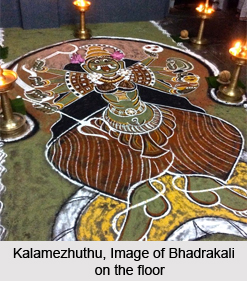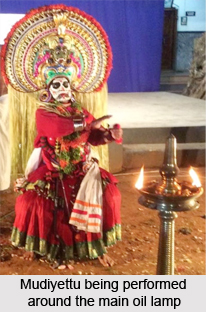 The performance of Mudiyettu, folk ritual theatre telling the mythological tale of the battle between Goddess Bhadrakali and the demons Daarika and Daanavendra, does not encompass any Mudras (hand gestures), facial masks and expressions, as found in other forms of art worship. Instead, facial make-ups and Chutti (art work made on the face with coloured rice paste) form a major part of Mudiyettu. During the initial years, Mudiyettu performance saw characters worship dance accompanied by speech. Later, dance and speech got replaced by rhythmic steps and the modified version garnered more acceptance.
The performance of Mudiyettu, folk ritual theatre telling the mythological tale of the battle between Goddess Bhadrakali and the demons Daarika and Daanavendra, does not encompass any Mudras (hand gestures), facial masks and expressions, as found in other forms of art worship. Instead, facial make-ups and Chutti (art work made on the face with coloured rice paste) form a major part of Mudiyettu. During the initial years, Mudiyettu performance saw characters worship dance accompanied by speech. Later, dance and speech got replaced by rhythmic steps and the modified version garnered more acceptance.
The eye catching facet in Mudiyettu performance is the engagement and participation of the viewers. When the artists get separated, the scene becomes dramatic. `Kooli` is a character who amuses the viewers with comic speech and action at this point, not seen in any other form of art worshipping. The sequence of Mudiyettu is quite distinct as well:
Kotti Ariyippu: This is the drum-beat announcement done after the completion of morning rituals in the temple. Chenda (high-pitch drum), Veekkam (low-pitch drum) and Elathalam (two cymbals made of bell metal or brass with heavy thread string as handles in the centre) are used.
Kalam Ezhuthu: A multicoloured large portrait of Goddess Bhadrakali called the Kalamezhuthu is made on the floor, using burned husk of paddy (for black), rice powder (for white), dried and powdered leaves of Acacia (for green), turmeric powder (for yellow) and lime powder mixed with turmeric powder (for red).
Kalam Pattu: After the night rituals are done in the temple, the chief artist chants devotional songs in praise of Bhadrakali, immediately after which he transforms himself as Bhadrakali in all spirits and disfigures the Kalam by wiping.
Chutti Kuthal: After disfiguring and wiping of the Kalam, the artists get into the Chutti Kuthal make-up and other make-ups similar to those in Kathakali. Head gears too are the same.
Vilakku Veppu: The lighting of a big oil lamp called Vilakku is done in this segment and the performance is done around this Vilakku.
Keli Kottu: This is the final announcement of starting of the performance. The Thaalam (rhythm) used for Keli Kottu is "Kuttanachi", a blend of "Alantha" and "Champa" Thalams.
The Mudiyettu drama has these characters - Lord Shiva, Sage Narada, Daarika and Daanavendra, Bhadrakali, Kooli and Koyimpata. There`s no rehearsal or preparation involved in playing the incarnation of Kali. The performance is a natural progression from Lord Shiva, Narada, demons Daanavendran and Darikan to Bhadrakali. A complete Mudiyettu performance requires a total of 16 persons - including percussionists, Kalamezhuthu artists and vocalists. The events presented in the Mudiyettu follow the given sequence:
1. Siva Narada Samvadam: It is the conversation between Lord Shiva and Sage Narada, where the latter approaches Shiva and narrates the incidents of suffering by the saints, gods and common people at the hands of the Asuras and requests him to safeguard them. Shiva promises an immediate solution. He opens his third eye and incarnates the fierce form of Bhadrakali from the sacred eye.
2. Daarika Purappadu: Daarika`s triumphant march after the Digvijayam or the conquest of the eight directions is presented in this episode.
3. Kaali Purappadu: Bhadrakali`s infuriated march to kill Daarika and Daanavendra is presented in this episode.
4. Koyimpata Nayar: Koyimpata Nayar (Lord Shiva"s bodyguard) is sent in disguise by Lord Shiva with Bhadrakali to help her, if need be, in the battle against Asura brothers.
5. Kooli Purappadu: Kooli is one of the Pancha Bhoothams, sent to assist Bhadrakali in her mission to kill the Asuras. The comic speech is introduced to minimize the tension before and during the battle.
6. Koodiyattam: The battle finally begins. Bhadrakali uses the sword, while Daarika and Daanavendra use Churika, a dagger-like weapon. A fierce battle takes place where the Asuras are inevitably defeated. They run away and take refuge in Pathalam, the kingdom of Asuras.
7. Daarika Vadham: Seeing the Asuras fleeing away for their lives, Bhadrakali gets infuriated. Koyimpata grasps her dagger becoming more destructive, removes her head gear and forces her to touch the ground with her sword, intending to calm her down. The Asuras plan to wage a Maya Yuddham (illusory battle) for which they are quite capable in the night for and wait for the dusk. Knowing their intentions, Kali spreads her long hair to conceal the sun, thereby creating an artificial dusk. The demons fall into the trap and return to the battle field, only to be miserably defeated by Kali. She enters the arena with Daarika`s and Daanavendra`s head gears, signifying their death, blesses all and disappears.
Some auspicious rituals are performed during Mudiyettu performance:
Among the spectators, infants and children are picked by Bhadrakali. They encircle the main oil lamp thrice. Then Prasaadam (ritual offering to the deity) is given. Here, the offerings are flowers from the garland on the head gear. The infants and children are blessed, and believed to have been immunized against contagious diseases and to live a long healthy life. This ritual is done after Kooli Purappadu and before Koodiyattam.
Thelli Eriyal ritual is performed in Purappadu and battle stages, with the essential cotton torches. Dried pine wood resin powder is thrown to the cotton torch flame. While the flames surcharge the scene, the medicinal properties of the smoke are believed to kill viruses causing contagious diseases. The ambience gets refreshed.
Pantham Uzhiyal is performed by Bhadrakali worshipping Lord Shiva after the battle is over. The flaming cotton torch that is used for the ritual is taken to devotees present and pine wood resin powder is thrown on to the flame, enabling the devotees to inhale the smoke, the most auspicious and valued act in the ritual.
Mudi Uzhiyal is the final ritual, after Pantham Uzhichal, where all the spectators, or say devotees, leave the place. Bhadrakali takes off the head gear and places it before the organizer or before the temple, and the Bhadrakali performer and other performers encircle it thrice. At this time, Prasaadam, i.e., flowers from the garland on the head gear, is offered when the reward for the performance, Dakshina, is given, ending the performance.
Related Articles:
Mudiyettu, Kerala Ritual Theatre
Forms of Indian Theatre
Kerala
Folk Theatre of Kerala
Classical Indian Dance Drama
Koodiyattam, Folk Theatre of Kerala
Ritual Theatre in India
Goddess Bhadrakali
South India Temples
Comic Relief in Mudiyettu
Costumes and Make up in Mudiyettu




